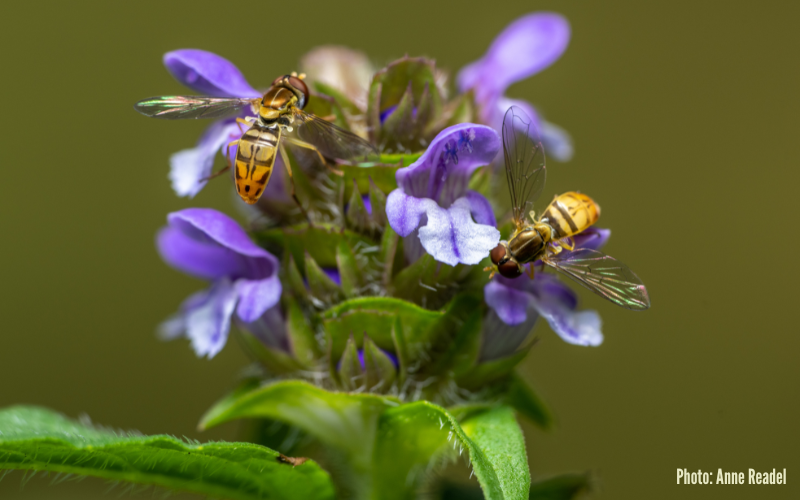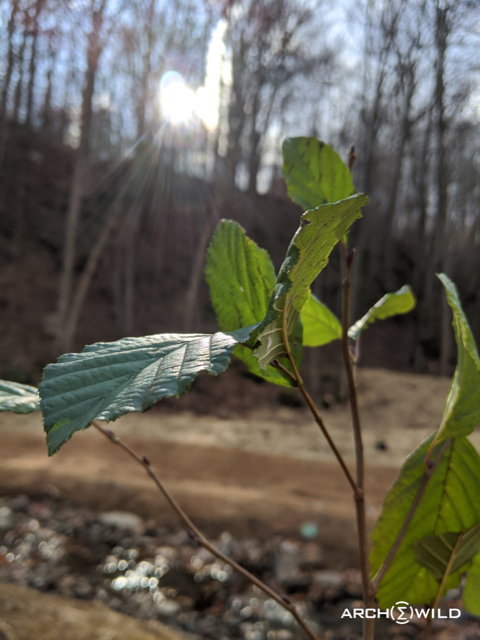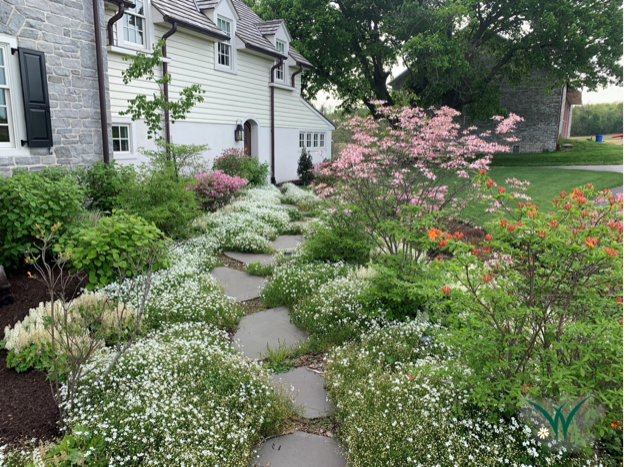By Grace Hassler and Grant Jensen
Est. Read Time: 8 minutes
Let’s be clear: wherever possible, Homegrown National Park™ encourages everyone to shrink the lawn and plant the most productive plants (keystone flowering plants or keystone trees and shrubs). We also understand that in order for everyone to participate in the native planting movement, their yards need to work for their needs. For many people, this means incorporating at least some turfgrass lawn into their landscape.
When figuring out which parts of your lawn to keep, Dr. Doug Tallamy, co-founder of Homegrown National Park™, suggests identifying the portions of your lawn you need for paths, pets, and play, and then dedicating the rest of your yard to native plants. A bee lawn can help make even the parts of your yard that remain turf attractive to pollinators.

Shifting a landscape from conventional turfgrass to a bee lawn doesn’t provide the same bump in ecosystem productivity as planting a range of native plants and trees. It does, however, still provide a significant improvement over a traditional lawn. So even though bee lawns are not the most valuable tool in the biodiversity toolkit, we think they’re worth discussing.
I spoke with James Wolfin and Ryan Schwab, Conservation Specialists at Twin City Seed Co. outside of Minneapolis, MN, to learn more about bee lawns, what makes them effective, and what you need to know to establish one in your own yard.
Read on to learn more about bee lawns and some tips for establishment that will set yours up for success!
What’s wrong with regular lawns?
Not all plants are created equal in the eyes of insects and pollinators. Most species have evolved to only be able to eat certain plants. Pollinators require pollen-producing flowers for forage (and can even be picky about which plants they get their pollen from). Typical manicured turf lawns provide neither food nor habitat and often include other environmentally harmful inputs such as herbicides, pesticides, and fertilizers to keep them “perfectly” green and weed-free. All of this together makes lawns ecological dead zones, which is troublesome given that we’ve planted over 40 million acres of them across the country. That’s why Dr. Tallamy lists shrinking your lawn as the #1 action we as individuals can take to help combat the biodiversity crisis.
Bee lawns – the “better” of both worlds
We recognize that turfgrass is great for a bundle of human outdoor recreation purposes, from walking to picnicking to sports fields. And for the places where it just makes sense to have a lawn, or for the people who just really love the look of a turf yard, switching to a bee lawn can help make these spaces functional for not just us humans, but our pollinator pals as well.
So what exactly is a bee lawn? The University of Minnesota defines it as “a mix of turfgrass and low-growing chemical-free flowering plants with the intention of supporting bees while maintaining the neat and functional aesthetic of a traditional lawn.” What that looks like in practice is a nice, primarily green groundcover with lots of lovely, colorful flowers scattered throughout it.
 Bee lawns are proving to be effective at increasing the biodiversity of yards. A study James Wolfin published last year found that lawns enhanced with low-growing flowering plants supported a significantly higher diversity of bee species, especially native and specialist species (bees that only forage on pollen from specific plants), compared to standard lawns that only contained naturally occurring white clover (a non-native plant). This is great news, as the populations of many native bee species are in serious decline, in part due to non-native, generalist honeybees outcompeting them for limited resources. The more acreage we can convert to plants that our homegrown bees can use, the better.
Bee lawns are proving to be effective at increasing the biodiversity of yards. A study James Wolfin published last year found that lawns enhanced with low-growing flowering plants supported a significantly higher diversity of bee species, especially native and specialist species (bees that only forage on pollen from specific plants), compared to standard lawns that only contained naturally occurring white clover (a non-native plant). This is great news, as the populations of many native bee species are in serious decline, in part due to non-native, generalist honeybees outcompeting them for limited resources. The more acreage we can convert to plants that our homegrown bees can use, the better.
Bee lawns can withstand mild to moderate traffic, making them an option for everywhere but the most intensively used parts of your yard. And while they do take some effort to establish (see below for tips), they require minimal maintenance thereafter. Bee lawns only need to be mowed every few weeks, shouldn’t require watering unless experiencing drought conditions, and use little to no fertilizer. You shouldn’t use herbicides and pesticides on bee lawns; this could kill the flowers in the mix and the pollinators you are hoping to attract. They can also handle light raking, although HNP recommends leaving your leaves where they fall whenever you can. Fallen leaves provide excellent habitat for many small creatures, particularly invertebrates, and several insect species overwinter under the leaf litter.
Where Bee Lawns Work Best (and where they don’t)
Choosing an appropriate site for a bee lawn is essential for its success. While they can be walked on like a regular lawn, they don’t stand up well to intense uses like dogs with the zoomies or sports fields. Because of this, consider using a bee lawn in more mild- to moderately-trafficked areas of your yard. As James and Ryan say, “pollinators in the front, recreation in the back.”
 Bee lawns do need to grow a tad taller (~3-5 inches) than a fully turfgrass lawn to avoid chopping off all the lovely flowers that make them so productive. Because of this height requirement, it’s important to consider factors like city ordinances, HOAs, and neighbors when deciding where to put one in your yard. We encourage those who are interested in adding a bee lawn to their home to use it as an opportunity to educate their community about the importance of pollinator-friendly landscaping! There are also some resources below for adding signage to your yard about your new bee lawn.
Bee lawns do need to grow a tad taller (~3-5 inches) than a fully turfgrass lawn to avoid chopping off all the lovely flowers that make them so productive. Because of this height requirement, it’s important to consider factors like city ordinances, HOAs, and neighbors when deciding where to put one in your yard. We encourage those who are interested in adding a bee lawn to their home to use it as an opportunity to educate their community about the importance of pollinator-friendly landscaping! There are also some resources below for adding signage to your yard about your new bee lawn.
While this article focuses on residential lawns, bee lawns are great for public spaces, too. There are plenty of municipal open areas that don’t receive a ton of foot (or paw) traffic that could be greatly enhanced by a colorful blanket of native pollinator-friendly blooms. James helped to establish several bee lawns in public parks around Minneapolis, and they were met with overwhelming positive support.
How to Establish a Bee Lawn
James and Ryan have some expert tips to ensure your bee lawn gets a strong start.
Timing
The best time to start a bee lawn is typically in late fall or spring after the last frost date of the season. Check with your state university’s extension program, your local garden center, or another planting resource available to you to determine the best seeding dates for where you live. Avoid seeding in the heat of summer.
Moisture
Bee lawns don’t require much watering once they’re established, but keeping the seeds moist until then is critical, particularly if you’re planting in the spring.
Pick your Seed Mix
Bee lawn seed mixes are becoming much more common and easy to acquire. Twin City Seed Co. sells a seed mix that consists of three species of native flowers and various grasses. Two of the three flower species in the mix, self-heal and yaak yarrow, are native to the entire U.S. The third, blue-eyed grass, is native to all parts of the U.S. east of the Mississippi River. Twin City Seed has also come out with a western bee lawn seed mixture, in which all the flowers are native to California, and many of which are native to much of the western U.S.
To make the mix affordable, they do use non-native fine fescues for the turfgrass. While they are exploring fully native seed mixes that use native grasses, the cost of those seeds is exceptionally high right now, and they want bee lawns to be financially feasible for everyone.
If you want to create your own bee lawn seed mix, James and Ryan recommend using fine fescues for your turf. Kentucky bluegrass is a second choice but will require much more maintenance.
A lot of research is going into creating region-specific bee lawn mixes. Check with your local garden center to see if they have anything designed for your area.
Seeding Method
The seeding method you choose will depend a lot on the site you’re starting out with and the time and effort you have available to prepare it. If you already have the right kind of grasses in your lawn and relatively few weeds, overseeding may be the right choice. If you want or need to start your yard from scratch, there are different lawn renovation techniques you can use that require varying levels of effort, time, and inorganic inputs.
Weeding
Give your germinating bee lawn the upper hand by weeding your yard while the new plants get established. If you need help identifying potential weeds in your new lawn, many university extension programs have online tools that can help! Here’s UMN’s Is this plant a weed? tool as an example. The iNaturalist app is also a great option to identify plants.
It’s OK to Start Small
It takes a lot of effort to keep a bee lawn happy and moist while it’s taking root. Consider converting just a small part of your yard first, and then expand it as it establishes.
Patience
Some flower species, such as creeping thyme (Thymus serpyllum), may not bloom the first year after establishment. Give them some time to reach their full potential.
Signage
 Signage is an amazing way to inform your neighbors about what you are doing. UMN has some printable bee lawn signs on their website, or create your own!
Signage is an amazing way to inform your neighbors about what you are doing. UMN has some printable bee lawn signs on their website, or create your own!
Visit UMN’s website for a more in-depth resource on planting and maintaining a bee lawn. NOTE: The advice on the webpage is tailored to Minnesota, and growing requirements in other parts of the country may vary. Consult with your local garden center or extension program to get the best suggestions for your area.
Less Talking, More Doing: Action Steps
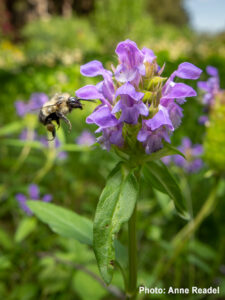 If you want to help increase biodiversity around your home, but aren’t able or ready to shrink your lawn (or have already reduced it as much as you can), a bee lawn may be a good compromise.
If you want to help increase biodiversity around your home, but aren’t able or ready to shrink your lawn (or have already reduced it as much as you can), a bee lawn may be a good compromise.
Below are some actions you can take to help make yards more functional for all the creatures that call them home!
- If you think a bee lawn is right for your yard and you don’t want to wait until fall to seed, start your planning now for a spring establishment.
- Look for education and funding programs in your state, like Minnesota’s Lawns to Legumes initiative, that can help you get your bee lawn established. If you have a program to share, comment on this article so others can find out about it!
- Talk to your local garden centers and landscapers to see if they carry native bee lawn seed mixes. If they do, see how much of the mix is native and confirm it contains no invasive species.
- Talk to your local representatives, clubs, places of faith, etc. about swapping out some of their turfgrass for bee lawn.
- Share this article with everyone you know and on your social media accounts.
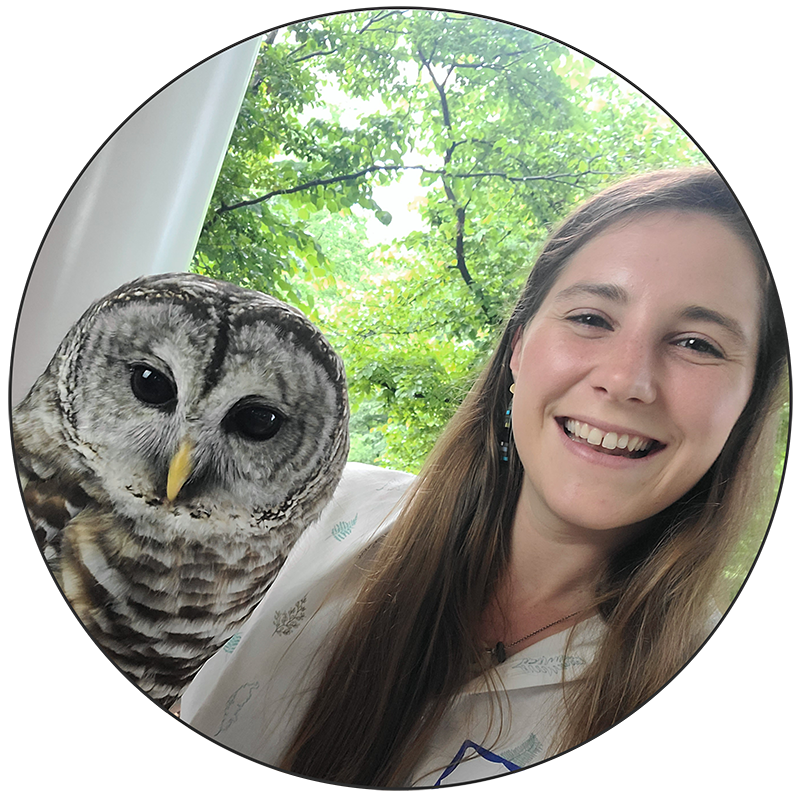
Grace Hassler recently graduated from the University of Pennsylvania with a Master of Environmental Studies degree focusing on local land conservation. She loves storytelling and finding ways to connect the public with important environmental research in a way that is interesting and understandable. In her free time, you can find Grace outside participating in one of her many hobbies – whitewater kayaking, birding, mountain biking, photography, rock climbing – you name it!
Photos by Anne Readel

